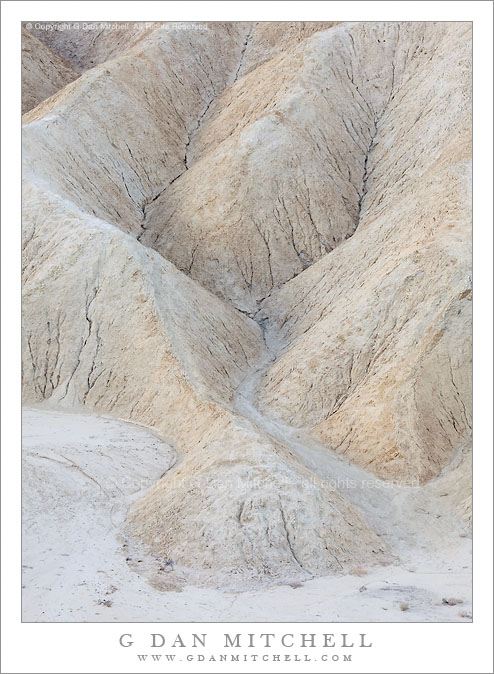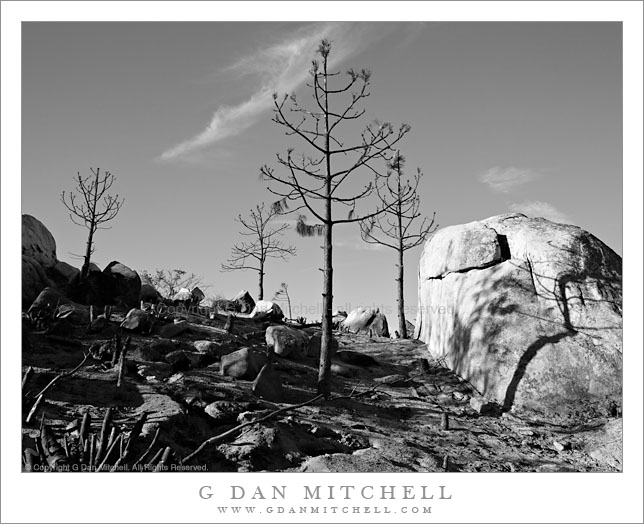Burn Zone, Near Foresta. Yosemite National Park, California. October 31, 2009. © Copyright G Dan Mitchell – all rights reserved.
Trees, stumps, and boulders in a recently burned area near Foresta, Yosemite National Park, California.
The story behind this photograph is a sad one, and one that provokes a certain amount of anger. The small village of Foresta is just on the western boundary of Yosemite National Park, above El Portal and below the road into Yosemite Valley from the highway 120 northern park entrance. A number of years ago – seems like perhaps 15 or so, though I haven’t looked it up – a tremendous fire started near Foresta and burned quickly and very destructively through a mature forest that had gone too long without burning. Because of the build-up of litter on the forest floor, the fire burned unusually hot and not only consumed small trees and low-lying plants but also destroyed a complete mature forest between Foresta and Tioga Pass Road where it finally was stopped.
This was one of the fires that probably made clear the terrible risks forests were facing due to many years of fire suppression – these forests evolved in a world of periodic fires and smaller fires to clear out the undergrowth the inevitable big fire has so much fuel to feed upon that the damage to the forest is ultimately much worse. For this reason, Yosemite (along with other parks) has adopted a wise policy of letting natural fires burn out on their own. Personnel are dispatched to keep an eye on the fire and to ensure that it doesn’t get out of control or threaten people or structures, but otherwise the fires are allowed to burn naturally. The price of some additional late summer smoke is, I think, a small price to pay for a more healthy forest.
After that original fire, what had previously been a forest along this section of the road instead became an open area. At first many small plants and wildflowers took advantage of the sunlight and grew like crazy. Eventually larger trees began to grow and in the past few years it was almost possible to imagine that a forest like the original one might eventually return.
One day in August this past summer I was camped in the Ten Lake Basin to do photography. On the second to last day I decided to leave my base camp and instead plan a dry camp on top of a ridge above the Basin from which I had seen a tremendous panorama of the Sierra crest on my way in. I packed up, carrying extra water, and climbed the steep trail to the pass. But as I climbed I smelled smoke, and as I came to the summit I saw a plume of forest fire smoke to the west… in the direction of Foresta. I gave up on the photography and hiked on out. I eventually found out that NPS personnel had been conducting a “management fire” near Foresta (on a very hot and dry summer day!) when it got out of control. This “little fire” burned right out of the Foresta area and into the surrounding hills and valleys, eventually consuming thousands of acres… including a good portion of the area of the previous fire that had slowly been starting to recover.
The tragedies of this fire are several. First, it is troubling that those in charge of actions designed to lessen fire damage to the forest miscalculated so badly that they ended up destroying substantial areas of the forest they were to protect. Even worse, the recovery of this area has now been set back by years, and perhaps decades.
This photograph is not in the public domain and may not be used on websites, blogs, or in other media without advance permission from G Dan Mitchell.
G Dan Mitchell Photography | Gallery | Twitter | Friendfeed | Facebook | Facebook Fan Page | Email
keywords: yosemite, national, park, valley, sierra, nevada, mountain, range, autumn, fall, season, scenic, travel, nature, landscape, california, wildfire, burn, zone, ash, boulder, rock, stump, tree, dead, sky, cloud, dirt, branch, forest, fire, foresta, nature, black and white, shadow, ecology, stock, desolation
Like this:
Like Loading...




